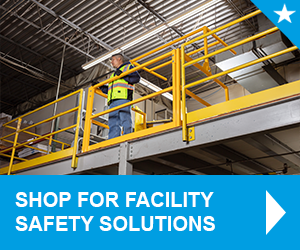
As the fourth quarter approaches, your objective is to maximize revenue so your organization can finish the year financially strong. And with the holidays seemingly coming sooner to retailers nationwide, you do everything you can to ensure you keep up with the increase in demand. Ramping up production in your warehouse and distribution facilities means increased foot traffic, more forklifts moving around, and busy loading docks. All of that increased activity adds to the risk of fall hazards that your workers regularly encounter.
What Are OSHA Fall Protection Requirements for Warehouses?
OSHA 1910.28 details your obligation to provide fall protection and falling object protection for your employees. This rule applies to all types of warehouses, distribution facilities, manufacturing plants, and other buildings in general industry. Specifically, you are required to provide OSHA-compliant fall protection whenever there is an exposed edge on a walking/working surface at a height of 4′ or more above a lower level. Areas you need to pay close attention to include:
- Mezzanines and Elevated Work Surfaces
- Elevated Walkways and Catwalks
- Loading Docks
- Stairways and Fixed Ladders
- Dangerous Equipment and Machinery
Ramping Up Fall Safety Efforts Ahead of the Busy Season
The best way to protect workers from falls is to completely eliminate the hazard. For example, you could stick to a single-story building rather than using mezzanines. However, this isn’t always possible. You need to utilize every square inch of your facility during the rush of the holidays and that means using the vertical space inside the building. It also means that workers have to climb ladders and stairs to get to upper levels, exposing them to the risk of falls. Before your facility gets busy for the season, it’s important to evaluate your fall protection equipment to ensure it’s up to OSHA standards.
Mezzanine Fall Protection
Elevated storage and workspaces help you make the most efficient use of your building. Protecting your employees on mezzanines begins with ensuring the ladder, stairs, lift or elevator entrance is protected with an appropriate handrail, and ladder safety system if required. Any exposed edges should be protected with a guardrail system that meets the guidelines in OSHA 1910.29(b) and a mezzanine safety gate at the entrance.
Elevated Walkways
Moving from one elevated area in your warehouse to another requires a catwalk or elevated walkway. As with your mezzanines, you should install a guardrail at the exposed sides to ensure employee safety and to be certain you are in OSHA fall protection compliance. Once workers traverse the walkway, they should be greeted by a self closing safety gate to continue the fall protection.
Stairways and Fixed Ladders
In order for workers to access mezzanines and catwalks, they’ll need to climb stairs or a fixed ladder. That means you must provide these areas with adequate fall protection. For stairways, that means an OSHA-compliant handrail and safety gate. For fixed ladders, a ladder safety system is required as well as personal fall protection equipment when necessary.
Warehouse Loading Docks
Easily one of the most important areas of your warehouse facility, loading docks are a flurry of activity during the busy season and it’s vital to inspect them and install safety equipment now. Trucks and trailers come and go throughout the day and night, each either delivering or retrieving essential loads. Loading dock safety is essential. Installing OSHA-compliant guardrails and loading dock safety gates help ensure workers stay safe as they work and traverse these busy areas.
Sensitive and Dangerous Areas
Safety gates and guardrails are also a great way to protect workers from getting too close to dangerous machinery and equipment. Restricting access to sensitive areas of your facility is possible using these simple, yet effective OSHA fall protection systems.
OSHA Requirements for Warehouse Safety Gates and Guardrails
In order to ensure that your workers are safe and your fall protection equipment meets OSHA standards, both guardrails and warehouse safety gates:
- Must be constructed of smooth materials that cannot snag clothing or equipment, scratch or puncture skin, or otherwise injure an employee.
- Need to be 42″ tall (measured at the top rail), plus or minus 3″.
- When a weight of 200 lbs. is applied to the top rail of a guardrail or mezzanine gate, it cannot fail or deflect to less than 39″.
- Midrails on guardrail systems and warehouse safety gates must be able to withstand 150 lbs. of force without failing.
Choosing the Right Fall Protection for Your Busy Warehouse or Distribution Center
Before you know it, the holiday orders are going to start rolling in and your facility is going to ramp up to maximum production levels. You have to be ready. Hiring and training new employees, solidifying partnerships, organizing logistics, and bracing yourself for the onslaught will only go so far. You also need to step up your efforts to protect your valuable workers.
There’s no time like the present when it comes to implementing enhanced fall protection protocols and equipment in your warehouse facility.
Expert Warehouse and Distribution Center Fall Protection Advice and Equipment
Not sure whether your facility is OSHA-compliant? Worried that your facility is lacking fall protection and putting you and your employees at risk? Schedule a safety inspection with a qualified safety expert to investigate your fall protection and to discuss what steps you need to take to make improvements.
We’re here to answer all your questions about OSHA fall protection requirements, loading dock safety, guardrails, or warehouse safety gates. Contact Fabenco today to learn more about OSHA 1910.28 and your obligation to protect workers in your warehouse or distribution center. We’re not only well-versed in OSHA regulations, we’re also experts in safety equipment. One of our qualified safety experts will be happy to assist you in determining what fall protection equipment is most appropriate for your application.





